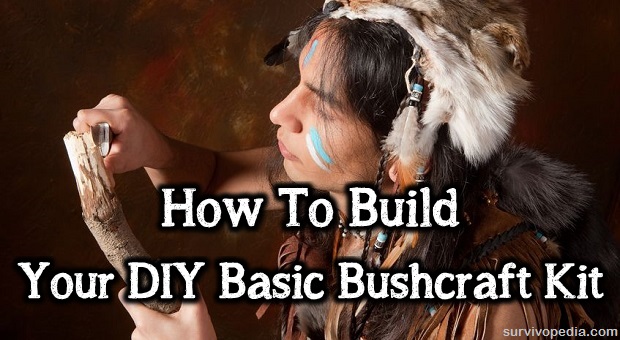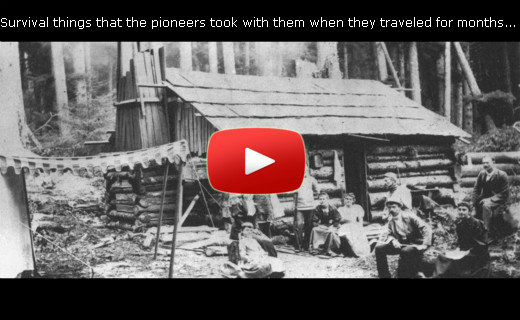Bushcraft was almost a lost art before the growing popularity of survival prepping also coincidentally stimulated a new interest in it.
Preppers began to get ready by stockpiling and planning, but they soon realized that no matter how well prepared you might be, in a long term apocalyptic scenario, sooner or later you’ll run out of supplies and resources unless if you are not already completely self-reliant. You might have to live off the land, as the expression goes, like our ancestors and the pioneers often did.
So now there are even schools giving hands on wilderness classes in the ”Art of bushcraft”. And some people have even chosen it as a permanent alternate lifestyle representing their personal satisfaction in the freedom of self-reliance and simple efficiency. This is also a kind of value producing protest to the out of control modern world so replete with wasteful consumerism and mind controlling technology.
Related: Bombproof Fire Craft: Build a “Next Fire” Kit that Cheats Death
This is a good thing because there is no substitute for individual skill sets and knowledge when it comes to basic survival, which helps with understanding some important differences between standard survival prepping and serious bushcraft. The obvious one would be that the current status quo of modern survival prepping relies greatly on advanced equipment and purchased stocked resources, and less on physical skills and knowledge of natural resources and your environment.
Bushcraft relies more on special skills and knowledge, and much less on equipment and technology. Even the personal carry pack or kit is a lot less than a typical mission oriented high-speed low drag modern BOB (Bug Out Bag) set up. But good bushcraft knowledge can often prove that less is really more.
Getting Started for the Least Expense
If you’re interested in learning the fascinating skills of bushcraft, you’ll need a basic bushcraft kit that goes wherever you go, especially ‘in the bush’ or wilderness. Back in the day these were known as ”every day kits”, ”ditty bags”, and other such nick names, and were carried by most people who traveled around a lot, and contained the basic personal essentials for survival, especially throughout the rural countryside.
You’ve seen the classic pictures of people back in the Great Depression days carrying a stick with a bandana filled with their stuff tied on the end of it associated with homeless drifters sometimes called ”hobos”? In fact, most of this was just a normal lifestyle until a person could get a job and become established somewhere.
Homelessness back then wasn’t associated with a mental illness or problematic social behavior as it is today. There were not many jobs out there for uneducated people other than factory or farm work. And the government didn’t yet establish the alternative social lifestyle of hand out State welfare for people who – for one reason or another – didn’t work for a living. So those without steady work or their own property or place to live survived by moving around from place to place seeking opportunity.
They usually traveled light because often they’d have to move fast or hop a train or just walk long distances and couldn’t carry much. Not to mention they didn’t have much in the first place. Most ”seekers” traveled according to the seasons and hospitable climate areas of the country. If they were knowledgeable and could live completely off the land for a while in between odd jobs at farms or towns, they really didn’t need a whole hell of a lot of exotic personal equipment. Today this is usually referred to as minimalist prepping. So a modern bushcraft kit does not have to be expensive to be effective.
The first thing to understand clearly for tool choices is the ”pyramid of priority” when you are suddenly alone somewhere, especially the rural/wilderness, with nothing but yourself and what you have in your pockets or are carrying. And you will have no choice but to camp out for the night. Your tools in this case, would necessarily be tailored to the bare essentials you’d need to facilitate the following:
- Shelter/security
- Fire Starting ability
- Water
- Food
The Bushcraft Bag
Theoretically advanced bushcraft experts can do just about anything they need with a knife and a fire starter/striker and little else they couldn’t just carry in their pockets. Pragmatic application notwithstanding, I hope that the pockets were attached to at least a snowmobile suit if they suddenly found themselves bushcrafting in a freezing nighttime weather situation and couldn’t maintain a strong all night fire for themselves.
And yes, I have seen people who can carry everything they need in their Cargo pants, on their belts, and/or in a jacket/vest with multiple pockets, to include a mylar pup tent, enough packed food for a couple of days, and even an animal trap for extended stays in the bush.
This is cool but the only problem with it is that your clothes themselves become the bushcraft kit bag and as such become ‘cumbersome’ and bulky. You can’t walk around everywhere these days in the same clothes only if you occasionally were practicing your craft, so you’d have to carry the clothes themselves around anyway.
While this is suitable for a dedicated outing, using the same set of clothes continuously is not an option most people will be agreeing with. Instead, it will be the tried and true shoulder bag or belt carry kit, which is what you usually see all the original mountain men and Native American Indians carrying. Obviously, this was also the prototype for the modern women’s purse. Because women, after all, always were the most expert of survivalists and preppers!
Leather bags were the traditional choice but a good leather bag is not cheap. However, there are many other inexpensive alternatives that will work just as well and can sometimes be obtained for next to nothing.
IMHO Military Surplus is the way to go especially if you’re on a budget. A lot of time and research originally went into the functional utility design of milsurp equipment and there’s always something somewhere that fits the needs of the survivalist.
At the local Fleet Farm store I picked up these two European Army bags, one a smaller Canvass compact backpack style ($4.95) and the other a waterproof shoulder square style of ideal size and portability for my own personal requirements and kit preferences.($2.95). And third is actually a nice heavy duty pigskin AK-47 four magazine pouch ($9.95) for shoulder or belt carry, which makes a very decent minimalist and comfortable to carry bushcraft kit bag.
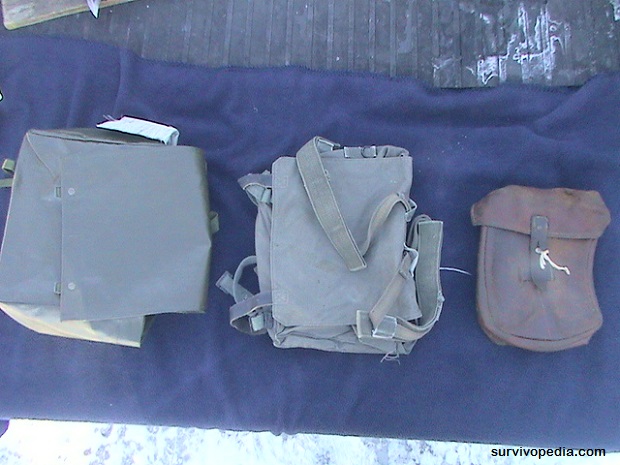
Bushcraft kits are modified or added to for particular use needs, preferences, range of operation, and other relative circumstances outside of their basic functional necessities.
While I like the compact backpack I chose the square waterproof shoulder bag because my axe fit perfectly in it, and it was just the right size to also fit everything in the picture below and even enough extra emergency food packs to last a day or two before you filled your game traps.
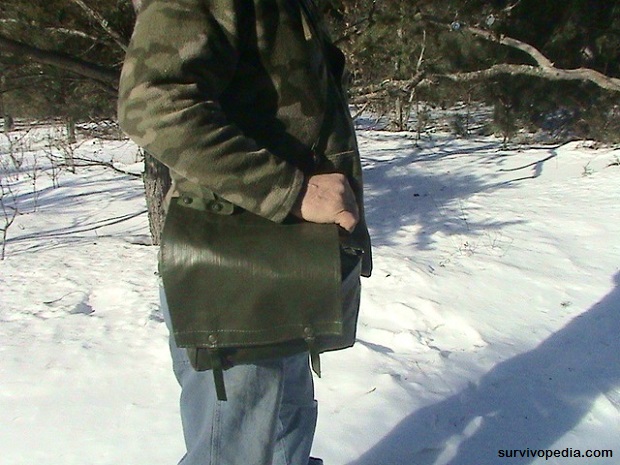
Let There Be Fire!
The ability to make a fire ranks as the most important single mechanical skill that bushcrafters must master above all else. Even if you are never in a below freezing climate, you still need a fire to cook raw food and to repel large predators. And where chances of below freezing weather occurs, knowing how to effectively and constantly start a fire anywhere becomes a matter of life or freezing to death.
The art of fire making goes back through history and is not as simple as it seems. Yes, many don’t believe that because they’ve been striking matches every day to light their cigarettes and candles and whatever and never had any problems. But that’s not the same as being stuck off the road in a freezing rain storm with 30 mph winds gusting deep in the woods where everything has been soaked for hours.
There are deliberately specific methodologies and reality that you must learn AND practice if you want to guarantee a fire start every time and a comfortable continuous campfire for heat and cooking. But first you should have some basic fire starting tools in your kit to facilitate starting the fire while you learn and master the ”art of the fire”.
Related: How to Find Water in the Wilderness
This is also a subjective preference choice as there are quite a few styles of fire starting tools besides the old standby of waterproof matches in a small watertight container. These are the cheapest method and usually work well unless you largely happen to be trying to start your fire in 30mph winds and freezing rain. Then you might prefer one of those blast matches in combination with some Wetfire tinder primer.
You also should consider redundancy in case you lose or break your fire starters. As seen in the kit picture below, I prefer a combination of the typical magnesium scraping block for tinder primer with the flint in the top, a couple of BIC lighters, and the old style small waterproof lighter fluid and flint match container. All together less than 10 bucks if you shop around.
If you want to be a traditionalist, you can even find original replicas of the kits the soldiers carried during the Civil War, including original flint stones and strikers in small metal tins that fit in a pocket. It takes a lot of practice to be able to light a fire in the wilderness with 100% success. But with these fire starting tools you can practice almost anywhere it’s safe to do so.
A Cut Above
You really can’t have a good bushcraft kit without having an edge over your environment. That means having a good field knife, AKA hunting knives or sheath blades, which are non-folding knives with blades of around four to eight inches, and is absolutely necessary for all around bushcraft utility.
However, there are so many choices, task variations, and price and quality variables that it’s a moot effort to even attempt a best choice suitable to everyone. But because the main qualification for bushcraft must be durability and strength, the choices narrow somewhat.
The primary qualifications would be a relatively thick blade with a full tang through the end of the handle, not one where the blade is merely connected to the handle somehow. Some of these non-full tang knives are reasonably priced and look good but these usually break on the first time out during hard usage. You also need a good whetstone for fine sharpening and a round chainsaw file for quick touch up or heavier duty on your hatchet.
Since we’re on a budget, Milsurp or used flea market or Amazon knives are the cheapest and work very well. There are also a number of these commercial camping/hunting models even at Walmart and other stores for under $20 that are full tang very heavy duty.
The following picks below are my excellent knives for bushcraft (from left to right). The first one is an U.S. Military Air Force survival knife with sharpening stone in sheath ($10 at a flea market). The second is a vintage Stolinger German made hunting knife from a flea market, with genuine stag handle. It was dirty and dull but became nice with a little elbow grease ($5.00). The third is an off the store rack commercial full tang heavy duty hunting knife from a few years ago ($3.00).
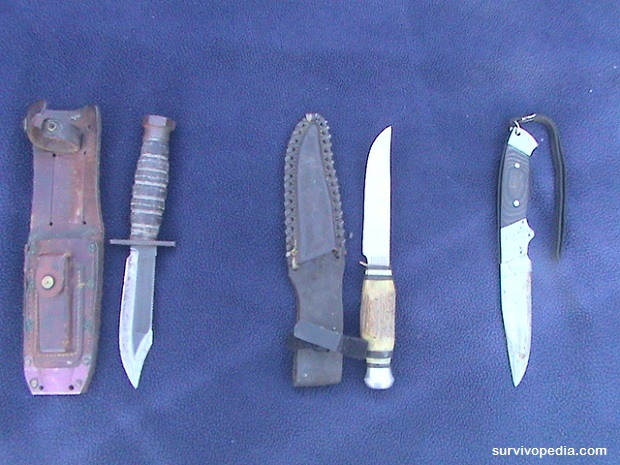
It’s also prudent to have a back-up knife in the form of perhaps a pocket folder or a food steak knife.
Fishing and Hunting Tools
The most common in the field bushcraft methods of collecting wild game for food besides hunting with a weapon, is by trapping and fishing. Fishing kits are also subjective and depending upon your skill can range from some simple drag line and a hook to a cool, but pricey take down micro fishing rod and reel and compact lures that fits discreetly in your bag.
Trapping with snares is a particularly torturous way for the poor animal of getting meat for yourself because of the inefficient killing nature of the snare, especially if you are not an expert with it, which almost nobody is.
Related: FAT GUYS IN THE WOODS: BLOG SKILL SERIES: Become a Fire Walker – Apache Match
Once had an old timer tell me he could taste the bitter difference in a rabbit killed with a snare, and one killed quickly with a bullet because of the systemic adrenaline spike and fear hormone release when the critter is dying in a slow, painful way. UGH! The snare shown in the picture below is a special design which doesn’t require the primitive diy figure 4 trigger and is a bit more effective in catching the poor critter, but still not that humane, but is compact and light enough and a quicker set up for a justified addition to your kit.
A quicker way would be one of those flat folding trapper style spring traps, which are more like They come in all sizes and usually ensure a quick clean demise if baited correctly, and fit not that badly in a kit or on a belt (approx. $10). A squirrel to raccoon size is shown in the picture below.
A word of caution: don’t even think you can just keep one of these in your kit and when the time comes you’ll just figure out how to use it. One or two broken or lacerated fingers later while you’re out bushcrafting, and I guarantee your enthusiasm for conquering the wilderness will change right back to the video game playing couch potato you might have once been. Get serious hands on training by someone who knows what they’re doing before playing with traps. And if you do have a trap in your kit, don’t forget a small container of peanut butter for bait.
Water and Cooking Containers
Again, there are a variety of choices here also, so research and make up your own mind on this. The military canteens and mess kits are always a good deal. The one in the last picture below is a sturdy aluminum two pot European model for $3.95.
Related: Making Fire With a Bow Drill
The Axe
For firewood and heavier woodcraft than you’d use your hunting knife for as well as other construction utility, an axe is indispensable. Also known as a hatchet, these extremely useful tools come in various types and styles.
The solo bushcrafter will usually opt for the smaller one-handed version that’s shorter and can be worn on the belt or in your Kit Bag if it fits like the one in the picture here does. It costs $2.00 at the flea market but $10.00 new almost anywhere.
I know there are a lot of cool compact portable saws and wire chain saw type devices you pull back and forth over the wood with a handle in each hand, but you better have the upper body power of a Gorilla to actually get enough done for a full day’s firewood. Where an axe is much faster, easier, and more efficient, again, if learn the proper way to chop with it.
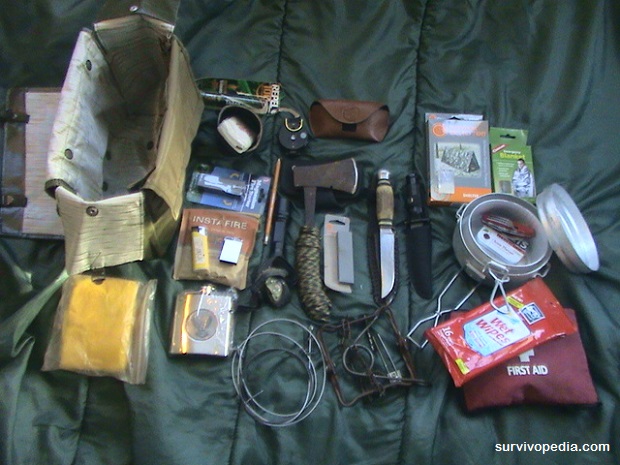
This, That, and the Other…
Well there it is. You now have a good basic bushcraft kit for around $35. Of course as time and money permit you will be changing or adding things depending upon your type of bushcrafting adventures and practice. For instance, if you are doing a lot of hunting and game dressing for the campfire cook out, you’ll want to carry more sanitary ‘wet wipes’ in a plastic sealed food pouch.
In the kit bag above I carry a few extras like a compass, a hand crank flashlight/radio, (not shown) a flask of 190 proof grain alcohol…and whatever else I might find useful if it fits.
After a hard day of chopping wood and setting up camp with a basic sleeping shelter, I don’t mind kicking back by the warm campfire and enjoying the sunset with a little background music, and a sip or two of libation as the night owls and other critters begin their evening concert…
I also like a small first aid kit, a mylar tube tent and a mylar blanket (also good for making a solar still), 50’ of paracord, and a day or so worth of emergency food rations. All cozy and comfy in the bushcraft bag. Ready to go at a moment’s notice when the time comes where I’ll always know that…
“…the forest is lovely, dark, and deep, but I have promises to keep…and miles to go before I sleep…and miles to go before I sleep…”
This article has been written by Mahatma Muhjesbude for Survivopedia.

